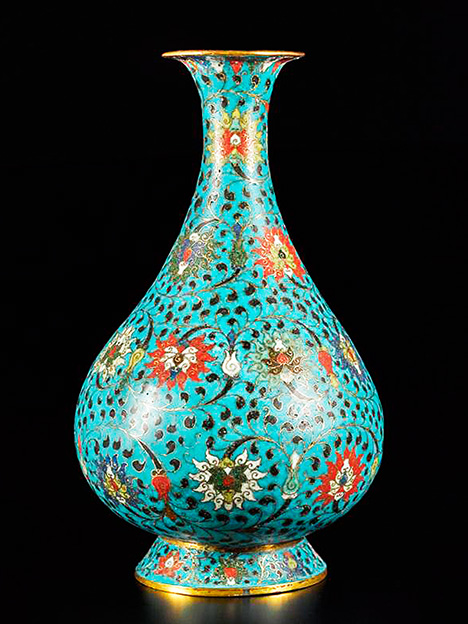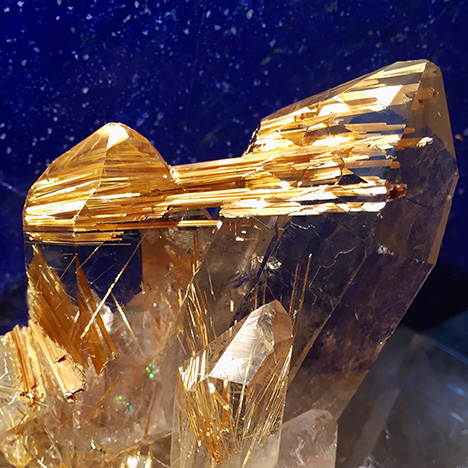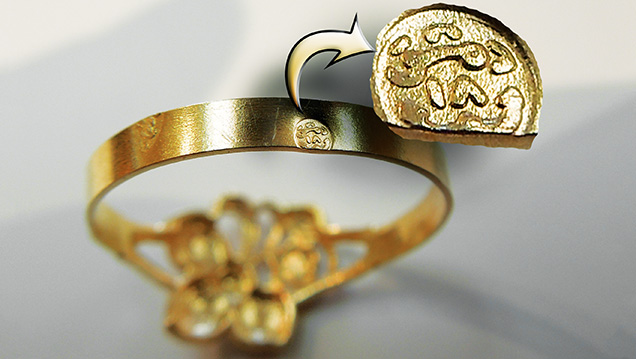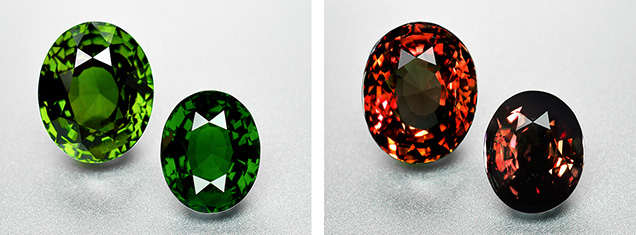General Gemology and Jewelry

Advances in Hydrocarbon Gemology: The Jet Group
Sarah Caldwell Steele
Whitby Museum, Whitby, United Kingdom
In mainland Europe, we first witness the utilization of gem-quality hydrocarbons for beads and amulets in the Upper Paleolithic. This was the period during which our hominid ancestors first developed complex language, culture, and art, laying the foundation for modern human civilizations. In the Americas, such artifacts are seen as early as 13,000 years ago. In the British Isles, Whitby jet (figure 1), arguably the highest-quality gem hydrocarbon in terms of stability, luster, workability and other attributes, first appears in the Early Neolithic. Almost certainly utilized for shamanic ritual, the jet group’s unique gemological properties make it quite literally a “magic” material. During the Medieval Era, these same attributes brought it to the attention of the alchemists as a potential candidate for the philosopher’s stone.
Despite this illustrious history, very little gemological research has been carried out on this culturally important material, and myth and folklore tend to prevail over hard geological facts. Adding to the problem, confusion in the nomenclature of gem hydrocarbons has given rise to a situation in which several structurally and chemically unrelated materials are often termed “jet.”
Exhibiting the phenomenon of reflectance impedance, jet has erroneously been described as a lignite—a low-grade coal deficient in hydrogen. In reality, jet forms a complex group of hydrocarbons, observed to be natural polymers with varying stability and durability, that are believed to reflect the level of crosslinking between polymeric chains. They are certainly far from the chemically homogenous and structurally amorphous materials previously described in the gemological literature.
Indigenous jet-working communities are still found in the Americas, Europe, and Asia. Yet a lack of gemological research has led to a situation where trading standards authorities cannot prevent the commercialization of foreign materials and simulants sold fraudulently as indigenous jet. Time is running out: The world’s gemologists must embrace the latest research to mitigate the threat to those communities maintaining one of civilization’s oldest gem trades.
REFERENCE
Steele S.C. (2016) Advanced jet testing. Gems & Jewellery, Vol. 25, No.5, pp. 22–25.
Color Origin of Gem Diaspore: Correlation to Corundum
Che Shen
Gemmological Institute, China University of Geosciences, Wuhan
Gem-quality diaspore, commercially known as “Zultanite,” occupies an important position in the gem market due to its unique optical phenomena, rarity, and color-change phenomenon. The material’s value depends on these factors. A clear understanding of color origin offers considerable benefits for gemological testing, cutting, and even valuation of diaspore. This study uses ultraviolet-visible (UV-Vis) spectra and laser ablation–inductively coupled plasma–mass spectrometry (LA-ICP-MS) to examine the color origin of color-change diaspore and to compare it with corundum. Diaspore and corundum have a similar chemical composition and crystal structure. The crystal structure of diaspore is connected by AlO4(OH)2 octahedra, whereas the corundum crystal structure is connected by AlO6 octahedra (Hill, 1979; Lewis et al., 1982). Both types of crystals are composed solely of octahedral units. Due to their closely related crystallographic structure, chemical composition, and spectroscopic (UV-Vis) properties, we may speculate that there is a close color correlation between diaspore and corundum. Consequently, this study adopts an analogy to address the color origin of diaspore by quantitatively analyzing diaspore from two geographic origins—Myanmar (formerly Burma) and Turkey—and comparing them with high-quality natural and synthetic corundum. The research aims to use the color correlation between diaspore and corundum to confirm the former’s color origin.
Table 1 shows the chemical composition (expressed in ppma) of two diaspore samples from Turkey (Dia-006, Dia-008) and two from Myanmar (Dia-Bur-001, Dia-Bur-002). We concluded that the Burmese samples contained more Cr, while the Fe content was higher in the Turkish diaspore. However, the V content of the Burmese samples was higher than that of the Turkish material, especially Dia-Bur-002 (358 ppma).

We compared the spectra of corundum collected from the o-ray with those of diaspore collected from the orientation of polarized light parallel with the a-axis (figure 1). In addition, all the UV-Vis spectra are calculated based on the Lambert-Beer law. The author used this method to acquire spectra in certain chromophore concentrations and path lengths. The results are convenient for comparison. In color-change diaspore, Cr3+, [Fe2+-Ti4+], and V3+ may all play a role in causing the color-change effect. The chromophore effectiveness of Cr3+, Fe3+, [Fe2+-Ti4+], and V3+ differs between diaspore and corundum. According to the calculation, the chromophore effectiveness of Cr3+, Fe3+, and [Fe2+-Ti4+] in corundum is about 5–10, 1.6, and 50 times higher, respectively, than in diaspore. However, the chromophore effectiveness of V3+ in diaspore is approximately 2–7 times higher than that in corundum.

REFERENCES
Hill R.J. (1979) Crystal structure refinement and electron density distribution in diaspore. Physics and Chemistry of Minerals, Vol. 5, No. 2, pp. 179–200, http://dx.doi.org/10.1007/BF00307552
Lewis J., Schwarzenbach D., Flack H.D. (1982) Electric field gradient and charge density in corundum, α-Al2O3. Acta Crystallographica, Vol. 38, No. 5, pp. 733–739, http://dx.doi.org/10.1107/S0567739482001478
Education as a Tool for Development in East African Gem-Mining Regions
Marvin Wambua1, Norbert Massay2, Robert Weldon3, Pedro Padua3, and Dona M. Dirlam3
1Amor Gems Ltd., Nairobi
2Pact, Washington, DC
3GIA, Carlsbad, California
In 2014, GIA distinguished research fellow Dr. James Shigley conceived an idea to help artisanal miners in some of the poorest gem-producing regions of East Africa. Dr. Shigley and Dona Dirlam and Robert Weldon of GIA’s Richard T. Liddicoat Library and Information Center, with GIA executive support, developed a plan for a guidebook for artisanal miners. The goal was to provide miners with very modest but valuable gemological concepts, empowering them to negotiate better prices for the rough material they sell.
Over the course of a year, the authors photographed numerous collections of rough material, mineral specimens, and cut stones. The authors conferred with members of the gem trade who are familiar with distant gem localities. They also received invaluable advice from Brad Brooks-Rubin, formerly of the U.S. State Department. The result of these efforts was a mainly pictorial booklet to accommodate all levels of literacy. Its few words were translated into Swahili. Selecting Gem Rough: A Guide for Artisanal Miners was printed on waterproof paper and made durable to withstand the rigors of mining activity. A resilient translucent plastic tray was designed to hold the booklet, and to evaluate and sort rough. Using the tray with transmitted light, miners could understand rough color zoning and determine gem integrity and clarity.
Because of the East African material represented, mining locations in Tanzania were the first to receive the booklet. GIA partnered with Pact, a U.S.-based nongovernmental organization (NGO), to identify Tanzanian regions where the book could be deployed as a pilot project. Pact’s plan incorporated government support of the project, and they identified the Tanzania Women Miners Association (TAWOMA), with mining projects east of Tanga, as an excellent group to participate in the pilot program.

In 2017, a GIA team and GIA East Africa consultant and alumnus, Marvin Wambua, met with Pact’s Tanzania branch representative, Norbert Massay, to start the pilot project. Some 80 miners received the education and the booklets. Two subsequent trips to different regions were conducted. A Pact report concluded that a 12% social return on investment (SROI) had been achieved. During the course of the study, the miners acknowledged an educational benefit that would last them a lifetime, with key concepts of gemstone value that could be passed on to other miners. Additional mining areas in central and southern Tanzania received training in 2018.
Enameling Chinese Cultural Relics
Shangjia Wen and Ren Lu
Gemmological Institute, China University of Geosciences, Wuhan
Jing-Tai-Lan, popularized in China more than 500 years ago and synonymous with cloisonné enamel, is characterized by opaque enamel materials on bronze, one of several classic enamel techniques dating back to the thirteenth century BCE. Furthermore, Chinese Jing-Tai-Lan is readily recognizable by its iconic set of colors—cinnabar red, malachite blue-green, pararealgar orange-yellow, and white—as well as traditional cultural patterns and religious reflections (figure 1). This particular style is deeply rooted in Chinese culture and has remained virtually unchanged over time. Yet the traditional combination of colors and patterns unique to Jing-Tai-Lan are not the best fit for a new generation of consumers.

Over centuries, various enamel techniques have been developed and used to create lasting artworks from many cultures of the world. In addition to cloisonné enamel, there are several other classic enamel techniques. Champlevé, which dates back to the twelfth century, features engraved or struck recessed areas subsequently filled with vitreous enamel. Some historic examples are religious plaques and emblems. Painted enamel (Limoges enamel) originated in the fifteenth century in southwestern France and is well known for its portraits and scenes on vessels. Piqué à jour enamel, which probably originated in the sixth century, has metal wires or cells filled with transparent vitreous enamel. This technique was used in some of the most iconic Art Nouveau pieces such as jewelry depicting delicate butterfly or dragonfly wings, Tiffany lamps, and luxurious vases. Today, these classic techniques and the overlap between them, along with choices of precious base metals and a full spectrum of opaque, semitransparent, and transparent enamel materials, have provided artists and jewelers worldwide with tools for unbounded creativity.
Contemporary Chinese consumers are increasingly searching for expressive styles and colors and diversified cultural reflections that suit their personal preferences and lifestyles. The 500-year-old historic Jing-Tai-Lan technique needs to evolve for the twenty-first century.
The authors are exploring the full potential of classic enameling techniques in revitalizing traditional Chinese cultural icons and historic relics. Our efforts are focused on fusing contemporary jewelry making with widely identifiable and readily acceptable Chinese elements drawn from cultural heritage and folk art, with the aim of enriching enamel jewelry for contemporary Chinese lifestyles.
The Evolving Supply Chain—How Greater Awareness of the Value of Mineral Resources Spawned a Movement to Restrict Their Outflow from Producing Nations
Stuart Robertson
Gemworld International, Inc., Glenview, Illinois
Traditionally, the colored stone industry has depended on a fragmented distribution channel of small-scale operators to transport gems through the multiple levels of the marketplace. In recent decades, producing nations, especially in Africa, have increasingly questioned the equity of a system in which the least economic benefit of the resource is retained by producers, while the vast majority of benefit is achieved by those closest to the retail consumer. Governmental regulations enacted to counter this perceived inequity have had a number of unintended consequences, such as forcing otherwise honest small-scale laborers to operate outside of the law just so that they can compete in the market.
This presentation examines changes in Tanzania’s gem market to illustrate the major challenges the gem industry faces in balancing the growing demand for supply chain transparency with a profitable finished product. As the traditional model for producing gem material faces increasing pressure, it is clear that the supply chain of the future will be significantly different. The emphasis on retaining value at the source is already influencing price and demand for certain popular gems. This move toward increased value capture by producing nations will inevitably reduce the size of the traditional wholesale market.
The Gem Collection at the Natural History Museum, London: A Collection of Collections
Robin Hansen
Natural History Museum, London
Gemstones, gem rough, and worked objects have been collected alongside mineral specimens in the Natural History Museum (NHM), London—previously known as the British Museum (Natural History)—for more than 270 years, creating one of the world’s outstanding mineralogical collections. Some 5,000 of the 185,000 specimens are gemstones or worked objects that constitute the Gem Collection. This collection grew by incorporating many smaller ones. The earliest gems are from Sir Hans Sloane, physician to the royal family in the late 18th century, whose vast collections formed the basis of what are known today as the British Library, the British Museum, and the NHM. Most notable were Lady and Sir A.H. Church’s gemstone rings (1915), Prof. Archibald Liversidge’s Australian gemstones (1927), Dr. A.C.D. Pain’s Burmese gemstones from Mogok (1973), and the collections of T.B. Clarke-Thornhill (1934) and C.R. Mathews (1993). Gemstones from Edward Hopkins (between 1906-1933) included a 598 ct morganite from Madagascar. The largest addition came from the merger of the British Geological Survey collection with that of the NHM in 1985, adding around 1,500 gems. Highlights included a pale blue 2,982 ct topaz from Brazil (the collection’s largest cut gemstone), a 57 ct padparadscha sapphire from Sri Lanka, a 424 ct kunzite from Brazil, a rare 20 ct Burmese sillimanite, a 146 ct peridot from St. John’s Island in the Red Sea, and the impressive diamond-studded gold snuff box of Sir Roderick Murchison, gifted to him by Czar Alexander II.
This historically important collection is a treasure trove of scientific, historical, and cultural knowledge. It serves as a reference for many of the developments and uses of different gem materials over time. Working alongside the mineral collection, the geological context is often preserved, adding significant scientific value. The collection is currently undergoing a re-curation program to enhance the data. Efforts to increase its accessibility and availability for focused research within the gemological and mineralogical communities will help to realize the Gem Collection’s full potential.
Gemology and Appraising: Similarities and Differences
Susan Eisen
Susan Eisen Fine Jewelry & Watches, El Paso, Texas
There are many similarities between the science of gemology and the science of appraising. When done accurately, both involve the study of information on a university level and a continued dedication to lifelong learning to stay aware of the constant changes happening. Both represent an amazing amount of enlightened knowledge occurring on a daily basis around the world. Both professions also require dedication to detail, the ability to do exhaustive research to come up with the correct answer, and a deep understanding and application of technology. Another similarity is the need to use subjective and objective reasoning to determine the results. Since both are sciences, using intellectual truths and adapting them to solve the problem helps in determining the correct results.
Identifying a gemstone is just half the battle in the appraisal of gems. Once the identity is determined, other parameters must be considered to estimate a gem’s value. In gemology, identification of the material and its internal characteristics is only part of the conclusion.
Gemstone Durability Chart
Kennon Young
Vermont Gem Lab, Burlington, Vermont
One of the most commonly misunderstood traits of a gemstone is durability. Many people believe that durability is based strictly on a gemstone’s hardness. Hardness is a gemstone’s resistance to scratching, but it does not account for a gemstone’s resistance to breaking and cleaving. Resistance to breaking and cleaving, as used in this presentation, will be described as “toughness.”

The chart above reflects common gemstones and their relative durability. Accounting for resistance to scratching, breaking, and cleaving can allow us to better understand how durable gemstones are.
The gemstones listed are mostly group names. Some species of these groups are noted at the bottom of the chart.
Good News and Bad News: Two Tales of Products of Endangered Species Used in Jewelry
Charles Carmona1 and Jo Ellen Cole2
1Guild Laboratories, Los Angeles
2Cole Appraisal Services, Los Angeles
Elephants as a species (figure 1, left) have been given a better chance to survive the twenty-first century and beyond thanks to the abolition of the legal ivory trade in China as of January 1, 2018. The world watched in horror as thriving populations of this majestic animal plummeted by 90% over the last 50 years, mostly due to poaching of their tusks for use in jewelry and decorative art. European export of ivory was banned in 2016, as were sales (with a few exceptions) in the U.S.
Ivory markets still exist in Asia and other parts of the world, but with lower demand from the largest consumers, prices will drop and the slaughter will lessen. Only when legislation and education reach this level in all markets will elephants and other sources of ivory be safe.
That’s the good news. Now the bad news.
The various species of precious coral (figure 1, right) are not so fortunate, as they are still not listed as threatened by the Committee on the International Trade in Endangered Species (CITES). Although some regions are restricting the harvesting of precious coral, in other areas there is no such concern. Divers are going deeper every year to take more coral for the demand created by the jewelry and decorative arts industries, which is far beyond its level of sustainability. Adding to that are the rising temperatures and acidification of the oceans due to climate change. At this rate, extinctions could occur in our lifetimes.

Only a concerted effort on all fronts can save these corals. Listing by CITES and research into coral farming are good starts, but ultimately it will require public education and research into alternatives to taking coral from the sea. Coral is already a gift. Let it be an inspiration to create jewelry and art from materials that are not endangered.
In response to the threats against coral, 2018 has been declared the third International Year of the Reef (www.iyor2018.org). Join The Ocean Agency, the Tiffany Foundation, Google, and many others to save this most precious resource for future generations.
The History and Current Status of Colored Gemstone Grading
Henry Ho and Barbara Wheat
Asian Institute of Gemological Sciences, Bangkok
Before color-grading systems were available on the market, people developed their own systems for judging color. The lead author has been involved in the gemstone business since he was a young child, helping his father sort and grade gemstones in his office. He has 55 years of experience in examining and judging color in gems and will share the history of colored gemstone grading in this poster.
The history will cover the GIA color system, Gemval, the CIE system, the Munsell color wheel, GemDialogue, Gemewizard, the Tanzanite Foundation grading system and the Miner’s System, and the ICSL System. References will be made to expert analysis in the field from notable industry leaders such as Joel Arem and Richard Drucker.
The current status of color grading will be addressed from the lead author’s perspective based on his extensive experience with colored gemstones, as a gemological laboratory owner and in the trade, as well as his discussions with color experts from around the world.
The Human (Humane) Trail: Finding Relevance in Jewelry Along the Pathway of Transparency
Brian Cook
Nature’s Geometry, Tucson, Arizona/Bahia, Brazil
Economic opportunity from the earth and sea comes into the hands of artisanal and small-scale miners (ASM) through hard labor and good luck. By 2017, approximately 40.5 million people were directly engaged in ASM mining, with five times that number dependent on ASM mining as a route out of poverty (Fritz et al., 2018). The chain of custody of gemstones mined by ASM, extracted from the earth and traveling as far as the red and green carpets at the Cannes Film Festival (the latter of which features celebrities wearing sustainable couture and jewelry) is a long, mostly opaque road. Mine-to-market transparency is the key to increasing consumer trust in the gem and jewelry industry while relating the rich stories associated with the lands, the cultures, and proud people that are the cornerstone of our trade.
As an industry, we have the opportunity to bring more benefit to ASM communities. Opportunities to invest in microfinance, mining and reclamation improvement, processing, and value-added enterprises—especially in parallel economic development with practices such as regenerative agriculture/agroecology—would align our industry with areas identified by the United Nations in 2015 as their Sustainable Development Goals (n.d.). In doing so, we would reshape the portrayal of gem mining as having a negative impact on people and the environment. Mining gemstones would be viewed as a way to bring economic benefit and environmental stewardship to potentially thousands of remote miners and their dependents.
In a remote exotic biome deep in Brazil, a model is forming around a unique gem resource known as Bahia golden rutilated quartz (figure 1). This material is sourced from the Rio dos Remedios group in the Espinhaco supergroup, a 1.7-billion-year-old narrow volcanic sequence with a range of unusual elements including yttrium, lanthanum, neodymium, titanium, iron, barium, and gold. The author and Kendra Cook have been associated with this mining community since 1983. In recent years, the author has helped to formalize operations and register miners into cooperatives. An initiative to implement sustainable economic, environmental, and cultural activities in this ASM community and connect it to our industry is underway, including the formation of a local NGO specifically to advance this initiative for the region. The aim is to create stories that add relevance to the jewelry industry, while initiating sustainable and measurable benefits for our first tier suppliers and their communities.

REFERENCES
Fritz M., McQuilken J., Collins N., Weldegiorgis F. (2018) Global Trends in Artisanal and Small-Scale Mining (ASM): A Review of Key Numbers and Issues. International Institute for Sustainable Development, Winnipeg, Canada, 91 pp. https://www.iisd.org/sites/default/files/publications/igf-asm-global-trends.pdf
United Nations (n.d.) Sustainable Development Knowledge Platform: Sustainable Development Goals. https://sustainabledevelopment.un.org/sdgs
The Impact of Fluorescence on Current Marketability
Richard B. Drucker
Gemworld International, Inc., Glenview, Illinois
According to GIA research conducted over a ten-year period and reported in Gems & Gemology (Moses et al., 1997), about 25–35% of all diamonds submitted to the GIA laboratory exhibited fluorescence. The listed range of fluorescence on a GIA grading report is none, faint, medium, strong, and very strong. Blue was the most common fluorescence color, accounting for about 97% of all cases (Shigley, 2014). About 10% of the occurrences of blue fluorescence were rated as medium or stronger. Other possible colors include yellow, green, orange, white, and red, with yellow a distant second. However, the GIA laboratory only lists the color when the fluorescence is medium or stronger, so data on the frequency of other colors is minimal.
Past research has found that in almost every case, any degree of fluorescence is a deterrent to market value. Prior to the late 1970s and early 1980s, some diamonds with fluorescence traded for a premium, but it was perhaps the investment craze and the demand for no fluorescence that started the initial deductions for fluorescence (Drucker, 2014). Over the years, the negative perceptions persisted and discounts became greater. Current research shows that the pricing deduction on average could be anywhere from a few percentage points for faint fluorescence to 30% for very strong. This study analyzed more than 89,000 diamonds to determine the approximate distribution of fluorescence strengths and colors for diamonds in the most popular carat weights and grades. The analysis also determined approximate discounts to the wholesale selling prices associated with these fluorescence categories, analyzing more than 76,000 diamonds.
Results of the study showed that 33.5% of the diamonds in this sampling did exhibit fluorescence, similar to results of the previous GIA research. Where the GIA research had about 10% of those fluorescing medium or stronger, this study indicated 15% at medium or stronger (of those that fluoresced). In the GIA study, 97% of those that exhibited fluorescence fluoresced blue, whereas in this study 99% were blue.
The chart below shows the discounts, calculated from this study, that are currently associated with fluorescent diamonds on the market. These percentage discounts have continued to be greater than in years past when similar research was conducted by this author.

REFERENCES
Drucker R.B. (2014) Effects of fluorescence—New research on pricing. World of Gems Conference, Rosemont, Illinois, September 21–22.
Moses T.M., Reinitz I.M., Johnson M.L., King J.M., Shigley J.E. (1997) A contribution to understanding the effect of blue fluorescence on the appearance of diamonds. G&G, Vol. 33, No. 4, pp. 244–259, http://dx.doi.org/10.5741/GEMS.33.4.244
Shigley J.E. (2014) Fluorescence, what’s changed. World of Gems Conference, Rosemont, Illinois, September 21–22.
Impacts and Expectations for the Fourth Industrial Revolution in Gemstone Faceting
Lee W. Haynes
LWH, Berkeley, California
As the world enters the Fourth Industrial Revolution, powered by computer and robotic technologies, the nineteenth- and twentieth-century manufacturing practices within the gemstone industry are being transformed. From computer numerical control (CNC) machining to high-resolution scanning and faceting optimization tools, yield and brilliance have increased substantially, and automation is projected to grow as more material is processed. These issues do not come without challenges and risks, and the economic model of low-cost labor to high-skill processing is a slow progression. In reviewing current automation processes and future technologies, there is a shift to enhance human capabilities with complementary automation processes. This shift is driven by many factors, from ease of implementation to material-dependent variables. Although there is progress in automation, there are challenges that constrain full automation. As a result, we will continue to see a need for continuing manual and human-driven processing for the next generation as full automation is adopted slowly based on labor force skill sets and capital return on investment (ROI) for new technology.
The Importance of Precious Metal Marks: Past, Present, and Future
Danusia Niklewicz, William Whetstone, and Lindy Matula
Hallmark Research Institute, San Francisco
Today there is a lack of understanding of the various types of marks that can be found on precious metals. This presentation seeks to enlighten the observer about the changing variety of marks and to better understand their importance.
When looking at the marks on precious metal jewelry, it is important to make the distinction between hallmarks and maker’s marks. They each serve as a guarantee of quality. Maker’s marks are applied by the actual maker or sponsor, retailer, and/or importer, and are generally referred to as a responsibility mark. These are guarantees that, by law, require that the fineness marked on the item actually state the metal’s true fineness.
Hallmarks (figure 1) are applied by a nationally authorized assay office to an item that has been submitted by the manufacturer or sponsor for scientific testing to verify the precious metal’s actual purity or fineness. Depending on the country and their hallmarking methodology, assay office hallmarks identify not only a metal’s composition but also the country of origin, the city of assay, the year or time period when the item was struck, and the approximate weight or length of that item. Hallmarks can be compared to an independent laboratory grading report on a gemstone or diamond: Both provide trusted testing and unbiased reporting of the facts about the item. While a diamond may have the report number inscribed on the stone’s girdle, a hallmark reports the test results by being struck into the mounting itself.

Not all countries in the world hallmark, but most European, Middle Eastern, North African, and some Asian countries have legislated compulsory hallmarking as a strong measure for consumer protection against the under-karating of precious metals so often found in non-hallmarking countries.
In the United States, the 1906 Gold and Silver Stamping Act, along with its 1961, 1970 and 1976 amendments, has clearly stated that any item with a fineness stamp (e.g., 18K, 950Pt, Sterling, etc.) must also be stamped with a federally registered maker’s or responsibility mark, referred to as a trademark. While manufacturers and retailers are required to register their marks as trademarks before applying a fineness mark on any precious metal item, the laws unfortunately are seldom enforced. Thus, many small companies, artisans, and importers do not register their trademark names or marks. Consequently, there are limited resources available for identifying modern U.S. maker’s marks, especially from the second half of the twentieth century.
As global foreign trade streamlines, so does the need for easier trading between hallmarking countries. Previously, when importing items between hallmarking countries, the item’s hallmarks had to be re-verified by a second assaying and hallmarking before being allowed for sale. In 1972, the Hallmarking Convention members signed a treaty to uphold consistent standards between member assay offices. Today, their strength comes from the unity of the 21 contracting member nations, all using the same agreed-upon Common Control Marks (CCM) as proof of compliance. These common marks are recognized by each member nation and also accepted by many countries globally. For more information, see www.hallmarkingconvention.org.
Introduced in 1988, Fairtrade and its certification mark have become internationally recognized proof that a product has met the required standards for responsible sourcing. With respect to an item of gold and associated precious metals, a Fairtrade stamp indicates that the metal, from ground to market, has followed verifiably traced fair and economic practices. As Fairtrade International notes, “Gold certified to Fairtrade Standards provides small-scale miners and their communities in developing countries the opportunity for better living and working conditions. Fairtrade also certifies Ecological (ECO) gold, which is mined under stringent ecological restoration practices, without the use of chemicals.” It is expected that the FAIRTRADE mark will become more prevalent on items of precious metal in the future. For more information, see www.fairtrade.net/products/gold.html.
Offshore hallmarking originated from the concept that hallmarking at the source could streamline the hallmarking regulations of the importing country. By setting up assay offices in countries that produce and export precious metal jewelry items but do not have the required hallmarking facilities—Indonesia, Thailand, and China, for example—the required hallmarking laws of the destination country can be fulfilled. This expedites the marking needs of the manufacturer/exporter by offering hallmarking services nearby.
Including offshore hallmarking services in Asia, Europe, Central Asia, the Middle East, North Africa, and the Far East, hallmarking now influences nearly 60% of the world’s population. Currently, with no nations in the Americas hallmarking, they are missing out on the best proven method of real consumer protection in the trade of jewelry and other precious metal items.
Jewelry Development Impact Index at the University of Delaware
Patricia Syvrud and Saleem H. Ali
Minerals, Materials and Society Program, University of Delaware, Newark
At present, the international jewelry industry lacks any measure or standard of how the sourcing and manufacture of jewelry and its components impacts developing countries. Because of its global complexity and fragmented nature, the jewelry industry supply chain calls for study and monitoring to enable countries and companies to exert a more positive influence, particularly in emerging economies.
After discussions at the Jewelry Industry Summit in Tucson, Arizona, in January 2017, multiple stakeholders within industry, government, and the academic community came together to propose the creation of a comprehensive, ongoing Jewelry Development Impact (JDI) index. The University of Delaware (UD) invited the JDI to become the signature project of a new interdisciplinary, graduate-level academic project, “Minerals, Materials and Society,” under the leadership of Dr. Saleem H. Ali. A grant was awarded by Tiffany & Co. Foundation to create The Gemstone and Sustainable Development Knowledge Hub (GemHub: http://sustainablegemstones.org), which will serve as a research arm within the Minerals, Materials and Society program at UD. GIA distinguished research fellow Dr. James Shigley sits on the GemHub Advisory Board, and senior research scientist Aaron Palke is an affiliated scholar and research partner.
The JDI is conceived as a relative country score that will measure the degree to which the jewelry and gemstone industries impact the economic and social well-being of each country in which they function. Created within the framework of the United Nations indicators of human security, the JDI will also capture examples of responsible sourcing and transparency initiatives that can be replicated, creating a “Roadmap to Responsibility” to assist with the implementation of the UN Sustainable Development Goals, the Organisation for Economic Co-operation and Development’s (OECD’s) Due Diligence Guidelines and environmental, social, and supply chain audits. As an initial step to the conceptualization of the JDI, academic research in the format of comparative case studies was conducted by graduate students at American University’s School of International Service in the fall of 2017 and spring of 2018. Elizabeth Orlando, Foreign Service Officer with the U.S. Department of State Office of Threat Finance Countermeasures, serves as special advisor to this project.
The results of the initial academic research will serve as a basis for the creation of a robust methodology for the JDI. The countries and products presented in this poster are: gold in Peru and diamonds in Botswana (fall 2017) and rubies in Myanmar and lapis lazuli in Afghanistan (spring 2018).
The New Economics of Diamond Mining
Russell Shor
GIA, Carlsbad, California
The discovery of diamonds larger than 50 carats used to be a rare occurrence, but in the past decade many such specimens have been found. The majority of these come from low-yielding “boutique” mines, which have been developed only recently. In addition, many existing mines have changed their diamond recovery processes to preserve larger crystals.
Two factors have brought about these changes:
- A vast increase in the number of high-net-worth individuals around the world, particularly in the Middle East, Russia, and China. These people and the dealers who work with them have become very active buyers of large diamonds, both privately and in the major auctions conducted by Sotheby’s, Christie’s, and others. As a result, the per-carat price differential between commercial-size diamonds and those over 10 carats increased nearly fourfold during the previous decade. Such price increases enabled these low-yielding boutique mines to become profitable.
- The development of new technologies to help identify larger crystals before they enter the recovery process. Improved X-ray technology can identify large crystals, fancy colors and stones without fluorescence that once might have been missed. In addition, the speed of X-ray identification has improved to the point where such units can be deployed prior to the crushing process, which previously destroyed or damaged many large rough diamonds.
The result is that discoveries of diamonds over 100 carats, a rare occurrence 20 years ago, have become relatively commonplace. Some of the largest diamonds ever discovered, including an 1,109 ct giant (1,111 ct before cleaning) from Botswana’s Karowe mine and a 910 ct stone from the Letšeng mine in Lesotho, have been found in the last ten years.
The case study will be Letšeng, which reopened in 2006. Its ore grade is about 1.5% that of the benchmark of one carat of diamonds per ton of ore. But the per-carat average price of Letšeng’s production ranges between $1,800 and $2,100, compared to the industry average of $118 per carat. Rio Tinto and De Beers mined it unprofitably during the 1970s before closing the operation in 1982. Rising prices for large diamonds in the 2000s have allowed the new owners to open and operate it profitably.
A Rare Nearly Pure End-Member Grossular Garnet with Color-Change Effect
Supparat Promwongnan and Apitchaya Buathong
Gem and Jewelry Institute of Thailand, Bangkok
Most color-change garnets (figure 1) in the gem market are intermediate in composition or solid-solution between pyrope and spessartine end members, with a trace of vanadium or vanadium-plus-chromium responsible for their color-change phenomenon. Some chromium-rich pyrope and grossular-andradite solid-solution with color-change effect have also been reported. In this study, two new color-change grossular garnets were examined at the Gem and Jewelry Institute of Thailand Gem Testing Laboratory (GIT-GTL). Their UV-Vis spectra (figure 2) and chemical compositions revealed a rare, almost pure end-member grossular with chromium plus iron as the significant color-causing elements.


Rolling Around in the Light—A Spherical Exploration of Gem Optics
Sylvia Gumpesberger
University of Toronto
Optical mineralogy theory has been thoroughly covered in many excellent gemology texts and journal articles, yet newcomers long to bridge the gap between theory and meaningful firsthand witness to the concepts that are so vital to the testing and characterization of faceted gems. The author investigated a variety of polished, transparent, single-crystal mineral spheres (including isotropic, uniaxial, and biaxial) using white light and polarizing filters to illuminate directional optics such as pleochroism, optic figures (interference figures), and their interrelationships through simple, accessible methods.
The spherically polished form of these transparent specimens (figure 1) eliminated the need for an external interference sphere/conoscope, avoiding much of the visual impediment of facet edges and their often confusing color reflections while allowing accurate approximation of angles for easily and successfully navigating and locating light effects.

Using transmitted light and a calcite or London-style dichroscope, it was evident that the greatest color separation of the ordinary (o-) and extraordinary (e-) rays in dichroic uniaxial minerals is at 90 degrees to the optic axis and that this axis, indicated by the optic figure seen through crossed polars and appearing at two opposite ends of the sphere, exhibited no pleochroism through the dichroscope. Further to this, it was clear from using the dichroscope that the e-ray departed in color from the o-ray in increments as the angle of the rays departed from the optic axis to the maximum color divergence or maximum differential absorption at 90 degrees to the optic axis.
Among other observations was the extinction effect. This was seen clearly down the c-axis in transparent tourmaline spheres, evident to the unaided eye in certain orientations when spheres were rolled slowly over diffused, transmitted light. The extinction direction was then confirmed by observing uniaxial optic figures in the same extinguished locations at opposite ends of the sphere when viewed under crossed polars. Note: In uniaxial minerals like corundum, the unpolarized optic axis direction and c-axis are the same direction, though conceptually different.
Biaxial gem spheres exhibited four typical biaxial interference figures that were easily located, and the 2V angle could be approximated. A dichroscope confirmed that the optic axis directions of biaxial gems also exhibited minimal pleochroism. Strong directional color could be seen in trichroic biaxial minerals such as the spodumene variety of kunzite and synthetic chrysoberyl, even unaided. A dichroscope separated the differentially absorbed wavelengths at angles other than the optic axes.
Rolling double refractive spheres slightly off the optic axis direction when viewed under crossed polars provided an insightful view into the variety of shadow pattern variations of conoscopic interference patterns sometimes seen through a petrographic microscope, when viewing polished thin sections containing crystal grains positioned with the optic axis slightly off-perpendicular to the thin section plane.
An instructional set of polished transparent gem spheres in a gemology classroom or lab can be very effective in engaging students in playful exploration, facilitating helpful observations that students can photograph for their notes, and builds skills and confidence prior to tackling high academic theory or testing small faceted gems. Further exploration could include the observation of directional spectra.
Of note to lapidaries, the preferable direction of color in synthetic ruby, though somewhat subjective, was observed down the optic axis of the sphere. Any angle of double refraction in this specimen exhibited some degree of differential absorption, a necessary consideration when choosing the relative angle of the table facet. Pleochroic spheres reveal the importance of considering directionality in cut design.
Science Has a Place on the Selling Floor
Maureen Moses
Adventure Gemstones, San Diego, California
Gemology, geoscience, and mineralogy—the sciences that help us understand gemstones—are the primary ways to comprehend gemstone rarity relative to the composition of the planet. Additionally, history and anthropology provide context to the value of gemstones, offering perspective on humans’ relationships with one of the most ancient luxury goods. Complete dismissal of the sciences can disproportionally weight the value of gemstones on their durability and beauty. This may result in an inadequate scope of selling points necessary for closing sales, especially for clients new to the high-end gem and jewelry industry. While there are clients who may find this information to be superfluous, preparation of talking points through gemology coursework and continuing education can help build an arsenal of information useful to sales professionals. A problem still exists where recent scientific literature is not disseminated in a meaningful way to the lay public, and the relevance of these discoveries remains masked by the authors’ technical language that is necessary to gain credibility within their own academic circles.
To bring science to the selling floor, Adventure Gemstones provides an additional tool geared to address this professional shortcoming. By utilizing modern science communication practices, the essence of these discoveries can be lifted and digested in a way that can be absorbed at the lay level, while furthering society’s understanding of the geosciences. Talking points, which can now be disseminated through blog posts and social media, will give sales professionals a way to speak to the adventure of gem formation, discovery, and recovery. They can also provide positive anchors for potential buyers to continue to weigh during their buying decisions. Adventure Gemstones seeks to add training modules for sales staff, with in-person trainings at stores and professional events, to give further clarification of modern research, and to democratize the science as a viable resource for the selling floor.
Supplementary Techniques with Potential to Assist in Freshwater Pearl Identification
Artitaya Homkrajae1, Chunhui Zhou2, Ziyin Sun1, and Troy Blodgett3
1GIA, Carlsbad, California
2GIA, New York
3GIA, Flagstaff, Arizona
Real-time microradiography (RTX) and X-ray computed microtomography (μ-CT) are the main techniques used by gemological laboratories to analyze a pearl’s internal structure in determining whether it is natural or cultured (non-bead cultured or bead cultured). Most freshwater non-bead-cultured (NBC) pearls contain characteristic twisted voids or elongated linear features toward their centers that easily separate them from their natural counterparts. However, some pearls possess borderline or overlapping growth features and exhibit external appearances that do not readily assist in their identification.
This presentation covers two supplementary techniques that offer some assistance in the identification of challenging freshwater pearls, specifically between American natural and Chinese NBC. Owing to its rich resource of approximately 300 Unio mussel species, North America has been an important source of natural freshwater pearls for centuries. For a number of reasons, however, mussel fishing is currently limited in the United States. Thus, most freshwater pearls in today’s market are NBC pearls produced in China.
The first technique is trace-element analysis using LA-ICP-MS. We analyzed 74 natural pearls reportedly from various wild Unio mussel species collected from North American lakes or rivers and 76 Chinese NBC pearls purchased from various sources. Since the pearls formed within different water environments, differences in chemical compositions and concentrations are to be expected. Linear discriminant analysis (LDA) was applied to the results obtained to provide additional helpful data. To enhance the study, we also included 75 American freshwater cultured pearls (both bead cultured and NBC) that were grown in very specific and well-defined conditions in Kentucky Lake, Tennessee. Therefore, their chemical compositions were likely to be more homogenous than those of the other sample base.

The second technique is deoxyribonucleic acid (DNA) bar coding. The work was first performed on five common pearl-producing species of American mussel collected directly from Kentucky Lake: pink heelsplitter, ebony, washboard, southern mapleleaf, and threeridge mussels. Additional DNA bar coding experiments were conducted on various freshwater pearl samples, and the DNA sequences of eight samples from different origins (Hyriopsis species, Megalonaias nervosa, and Potamilus species) have been successfully identified. If it can be proved that the DNA of a specific pearl matches a native U.S. mussel species, this would in theory suggest it is natural, since no commercial culturing exists in the United States today. Even though the washboard mussel was once predominantly used to culture American pearls, most American NBC pearls contain unique internal structures that, combined with their characteristic external appearance, allow them to be separated from natural pearls.
LA-ICP-MS and DNA techniques have the potential to help in determining the identity of freshwater pearls. Further studies on samples from various geographic locations and an even larger data set are needed for trace-element analysis. The DNA barcoding technique is conclusive in identifying mussel species, provided enough DNA can be extracted. However, the analysis requires a suitable sample size, and this may preclude its use on historical and valuable items.
University of Arizona Gem and Mineral Museum and Endowed Chair in Gemology
Zakaria Jibrin, Eric W. Fritz (presenter), and Robert T. Downs
Department of Geosciences, University of Arizona, Tucson
The University of Arizona Gem and Mineral Museum in Tucson supports and advances the study of gems and minerals through the quality and scope of its mineral collection and exhibits. The museum fosters an appreciation for the wonders of Earth and our solar system, while serving the needs of students, faculty, and the general public. To further this mission, the university is building a state-of-the-art gem and mineral museum in Pima County’s historic courthouse (figure 1) featuring a mineral evolution hall, the Arizona Mining & Minerals Gallery, and a gem hall that includes a vault for special exhibits. The space will encompass approximately 11,700 square feet.

The university’s 40,000 specimens will be housed in the new facility. The museum is offering partnerships with organizations and entities related to gems and minerals. This Community Outreach Education Group will have space for offices, public meetings, classrooms, and skill-building workshops.
One of the more exciting aspects of the new museum will be its laboratory with a unique public viewing area where visitors can observe scientists working on gem and mineral research. The lab will feature the latest technology for characterizing minerals and authenticating gemstones: Raman and infrared (IR) for vibrational spectroscopy, X-ray diffraction (XRD) to characterize the crystallographic and structural properties, and mass spectrometry for chemical and isotope analysis of gemstones and minerals.
An undergraduate program and a graduate program for master’s and PhD students emphasizing gemological research and skills, along with an endowed professorship, are made possible through a collaboration with The RealReal luxury consignment company. The Gemology Professor will be required to sustain a world-class research program, obtain grants, and publish in peer-reviewed journals. He or she will interact with the existing mineralogy program and share lab facilities such as the X-ray diffractometer, the Raman and IR spectrometers, the electron microprobe, the LA-ICP-MS instrument, and other advanced equipment. The professor will be able to choose his or her own research interests, but it is expected that they will integrate with the university’s RRUFF project and provide expanded outreach to the gem trade by adding to the gem database (rruff.info) that is freely available online.



